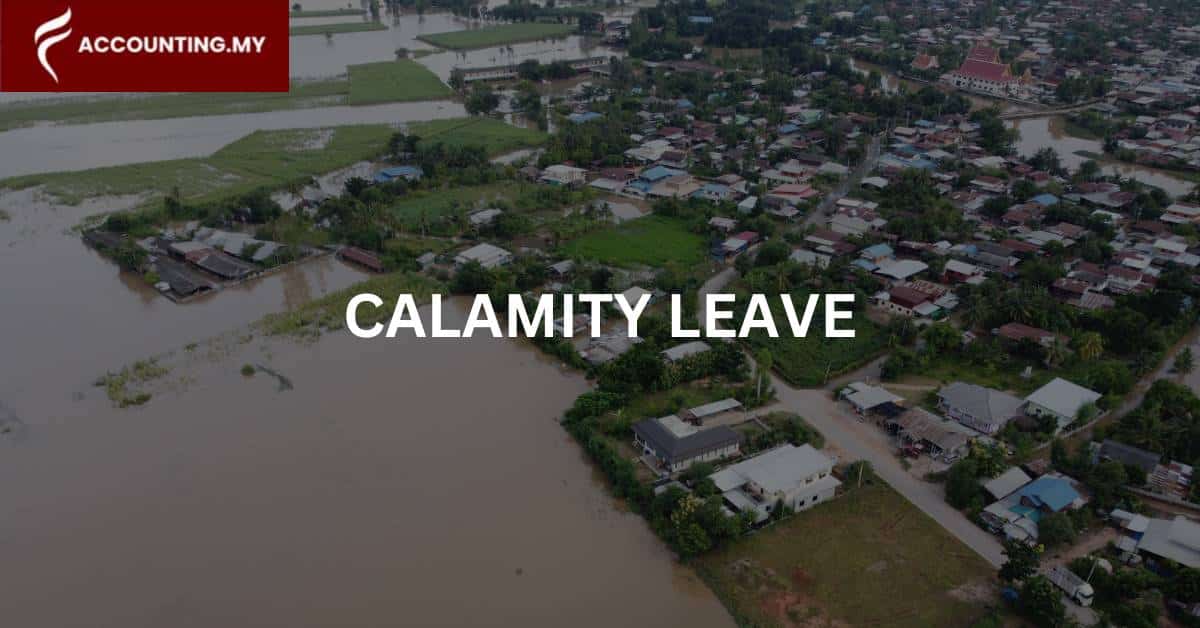Key Takeaways
- Calamity leave allows employees to take time off when natural disasters or severe emergencies disrupt their lives.
- It is not mandatory under the Employment Act 1955, but many employers now include it as part of internal HR or welfare policies.
- Common examples include floods, landslides, or fires affecting one’s home or safety.
- Supporting documents (police or fire reports, photos, local authority confirmation) are often required.
- Employees may receive one to five days of paid or unpaid leave, depending on company policy.
Calamity leave is a special type of time off granted when your life or home is hit by a disaster, such as floods, landslides, or fires. It’s not a legal right under Malaysia’s Employment Act 1955, but many employers offer it out of compassion to help staff recover from crises.
When the flood waters gush into your living room faster than your manager floods your inbox, work suddenly takes a back seat, especially when monsoon season hits.
Calamity leave exists for these unpredictable moments, because sometimes, life throws water, not deadlines.
As part of our “labour law” series, we will break down exactly what calamity leave means in Malaysia, who qualifies, how long you can take, and what employers and employees should know.
What Is Calamity Leave in Malaysia?
Calamity leave is a special type of leave granted when a natural disaster or catastrophic event directly affects an employee’s life, family, or property.
Unlike annual or emergency leave, it recognises that recovery after a flood or fire takes time.
Employers grant this leave to give staff breathing room to stabilise:
- Living conditions
- Manage repairs
- Relocate temporarily
All before returning to work, this is especially common during nationwide disasters like monsoon floods or landslides, which at the time of writing, Malaysia is experiencing quite severely.
Is Calamity Leave Legally Required?
No, Malaysia’s Employment Act 1955 does not require employers to provide calamity leave. It is therefore a discretionary benefit.
Companies may choose to:
- Treat it as a paid humanitarian leave;
- Grant unpaid time off; or
- Require employees to use their annual leave quota.
Nevertheless, modern HR trends lean toward compassion.
MEF has noted that many collective agreements include calamity-related benefits, and in practice employers often provide 1–7 days of paid leave for affected employees, depending on policy.
When Can Employees Apply for Calamity Leave?
Qualifying events include:
- Floods that force evacuation or damage your home.
- Landslides or earthquakes that make travel unsafe.
- House fires or electrical hazards requiring relocation.
- Government-declared disasters such as major storms or haze emergencies.
Proof such as a police report, evacuation notice, or photographic evidence helps HR verify the claim.
“The Petronas gas pipeline explosion near Putra Heights, Selangor in April 2025, forced nearby residents to evacuate for safety. Employees affected by the blast or road closures could justifiably apply for calamity leave, as the incident directly disrupted their living conditions.” – Malay Mail
When It Does Not Qualify
- Your cat’s tummy aches or your pet needs a vet visit.
- The internet goes down or there’s a short power outage.
- You’re late due to traffic jams or flash rain on the way to work.
- A car breakdown or flat tyre delays your commute.
- You need time off for personal errands, minor repairs, or moving house (unless caused by a disaster).
These situations may fall under emergency leave or annual leave, but they’re not calamities in HR terms.
How Many Days Are Usually Granted?
The number of days differs by organisation:
|
Employer Type |
Days Granted |
Paid/Unpaid Status |
Notes |
|
Public Sector / GLC |
2–3 days |
Paid |
Extensions possible for severe events |
|
Private SME |
1–2 days |
Usually unpaid or deducted from annual leave |
Case-by-case approval |
|
Large Corporation / MNC |
3–5 days |
Paid or half-pay |
Often framed under compassionate or emergency leave |
Note: Some corporations may frame it under compassionate leave.
How to Apply for Calamity Leave
When emergencies hit, proper documentation and communication make all the difference, even if it can be difficult.
Nevertheless, follow these steps to ensure your calamity leave is processed smoothly and fairly.
1. Notify your supervisor or HR immediately
Even a quick call, WhatsApp message, or email is enough when you’re in crisis.
Early notice helps your employer arrange temporary coverage and shows responsibility on your part.
2. Submit A Written Notice Once Things Stabilise
After making sure of your safety (and your loved ones), send a formal message or fill out the company’s leave form.
Include the dates affected, brief description of the incident, and expected return date.
3. Attach supporting documents
Provide proof such as photos of the damage, police or fire department reports, or statements from local authorities.
These details verify your eligibility and speed up HR approval.
4. Wait for HR confirmation
HR will determine whether the leave is paid, unpaid, or offset against annual leave, depending on internal policy or management discretion.
Keep a copy of the approval for your records.
5. Maintain communication during your absence
Stay in touch if your recovery or repairs take longer than expected. Prompt updates prevent misunderstandings and show professionalism, even in difficult circumstances.
“If your company doesn’t have a calamity leave policy, you can request that your absence be considered under emergency or compassionate leave, with documentation to justify the situation.”
Calamity Leave vs Emergency Leave vs Compassionate Leave
|
Aspect |
Calamity Leave |
Emergency Leave |
Compassionate Leave |
|
Trigger |
Natural disaster or public calamity |
Personal urgent matter |
Death or serious illness of family |
|
Legal Status |
Company discretion |
Usually covered under annual leave |
Statutory for some sectors |
|
Duration |
1–5 days |
1–2 days |
2–3 days |
|
Documentation |
Required |
Rarely required |
Death/medical proof |
Why Calamity Leave Matters More Now and Beyond
With Malaysia experiencing more frequent natural and environmental disruptions, calamity leaves are seen as part of risk management, employee welfare, and brand reputation.
The reality is clear:
- Climate Change
- Safety concerns
- Social expectations
Have changed the way HR must plan for crises.
Reasons It Matters Today
- Rising frequency of floods and extreme weather: Seasonal monsoon damage is now an annual certainty, not an exception.
- Urban vulnerability: Dense areas like Klang Valley and Penang experience longer recovery times due to infrastructure strain.
- Public empathy expectations: Malaysians increasingly expect employers to act with compassion during national or local disasters.
- Operational continuity: Calamity leave supports business recovery by allowing staff to rebuild safely before resuming work.
“During the Nov–Mar 2023/24 monsoon, NADMA reported 92,534 people (27,505 families) affected nationwide, and multi-year studies note increasing flood frequency and severity in Malaysia” – NADMA
Employer’s Role and Responsibility
Malaysian employers must act with empathy and understanding when disasters strike.
Just because calamity leave isn’t mandated by law doesn’t mean it should be ignored. Thoughtful policies protect both people and productivity.
After all, no employer wants to become the next headline in The Star with a story like, “X Company makes staff wade through flood waters to get to work.”
Build a Transparent Policy
Define calamity leave clearly in the staff handbook. Outline:
- Who qualifies
- How long they can take
- What documentation is needed
We recommend an employee handbook for clear communication to prevent confusion during critical times.
Show Empathy and Flexibility
During declared disasters, flexibility matters more than forms.
Many companies now extend temporary housing assistance, salary advances, or interest-free loans to affected employees. These gestures build loyalty and morale when it matters most.
Ensure Business Continuity
Incorporate calamity leave into your disaster recovery and workforce planning.
Assign backup roles, cross-train staff, or enable remote work where possible so business operations continue smoothly while affected employees recover.
Maintain Compliance and Records
Even though calamity leave is non-statutory, maintaining records of approvals and employee communication supports fair and consistent HR practice under the Employment Act 1955.
Documented procedures also help during audits or disputes.
Conclusion: Compassion and Clarity Go Hand-in-Hand
Calamity leave may not be required by law, but it reflects an employer’s compassion and an employee’s responsibility.
- For employees, understanding the process ensures peace of mind when life turns unpredictable.
- For employers, a clear policy promotes trust, morale, and business stability.
By highlighting your people-first initiatives, whether it’s paid disaster leave, relief assistance, or flexible remote arrangements, you not only support your team but also build genuine public trust.
At Accounting.my, we streamline your payroll, bookkeeping, and audit preparation so that your HR and finance workflows remain stable even during difficult periods.
If you want guidance in setting up clearer leave structures or disaster response processes, we are ready to assist.
Disclaimer: This article is provided for general information only and does not constitute legal, HR, or financial advice. Employment obligations can vary by company policy, collective agreements, and applicable Malaysian laws/regulations.
Source:
- Employment Act 1955 (Act 265) • Jabatan Tenaga Kerja Semenanjung Malaysia (MOHR)
- List of Collective Agreements (with “Paid Calamity Leave” clauses) • Malaysian Employers Federation (MEF)
- Leave Facilities (Unrecorded Leave – public service) • Jabatan Perkhidmatan Awam (JPA)
- Kemudahan / Amenities (JPA)— General leave facilities/circular references for federal civil service.
- Cuti kerana Bencana Alam (FAQ) • JPAN Sabah (State Public Service Dept) • accessed 2025
- Haze: Emergency declared in Muar & Ledang • Ministry of Natural Resources & Environment (archived news)
- API hits 750 in Muar, emergency status declared • TODAY Online
- Malaysia: East Coast Monsoon Flood 2024 (Emergency page) • IFRC
- Malaysia Flood 2024 – DREF Operation (MDRMY011) • ReliefWeb / IFRC • 9 Dec 2024
- NADMA media updates (examples of evacuee counts, 2025) – Government figures for flood-affected evacuees (illustrative, not a 10-year trend).
- Reuters coverage of Putra Heights pipeline fire & aftermath — Independent confirmation of injuries, evacuations, and supply impacts.
Frequently Asked Questions Calamity Leave in Malaysia
Floods, landslides, fires, earthquakes, or other disasters officially recognised by local authorities.
Sometimes. It ultimately depends on company policy. Many private firms offer one to three paid days, while smaller businesses may classify it as unpaid.
Yes, if the event does not directly affect you or if the company has no policy covering such leave. However, denial should be reasonable and documented.
Yes. Many employees extend recovery time by adding annual leave once the calamity period ends.
Provide photos, evacuation orders, or police/fire reports to validate your claim.
Not automatically. The federal public service uses unrecorded leave in defined cases (bereavement) and department-head discretion for general emergencies. Policies can differ by ministry/agency.















